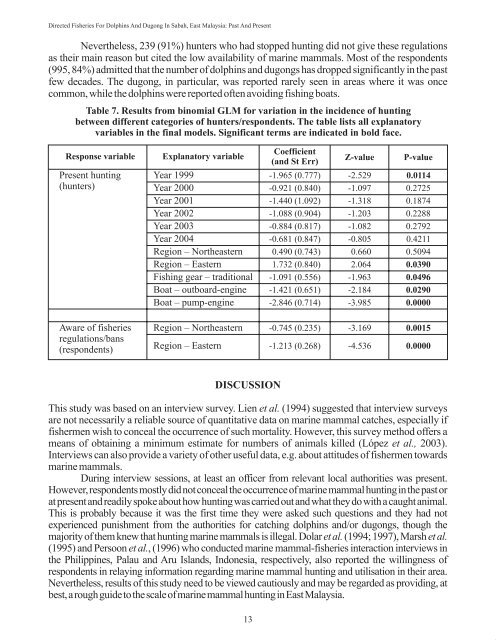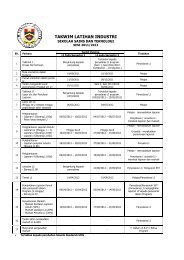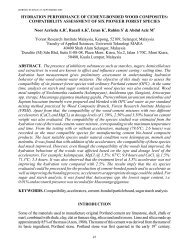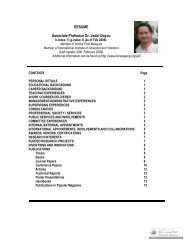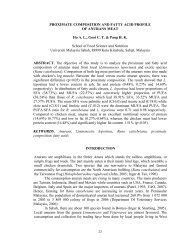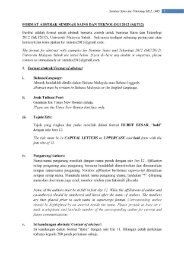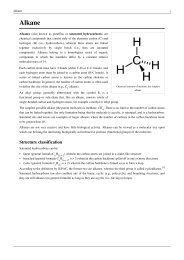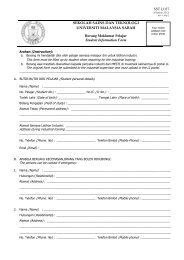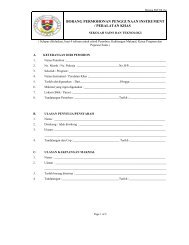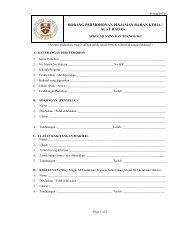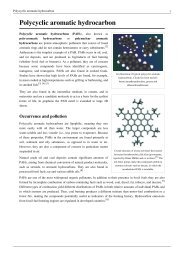Volume 23 - SST - Sekolah Sains & Teknologi - Universiti Malaysia ...
Volume 23 - SST - Sekolah Sains & Teknologi - Universiti Malaysia ...
Volume 23 - SST - Sekolah Sains & Teknologi - Universiti Malaysia ...
- No tags were found...
You also want an ePaper? Increase the reach of your titles
YUMPU automatically turns print PDFs into web optimized ePapers that Google loves.
Directed Fisheries For Dolphins And Dugong In Sabah, East <strong>Malaysia</strong>: Past And PresentNevertheless, <strong>23</strong>9 (91%) hunters who had stopped hunting did not give these regulationsas their main reason but cited the low availability of marine mammals. Most of the respondents(995, 84%) admitted that the number of dolphins and dugongs has dropped significantly in the pastfew decades. The dugong, in particular, was reported rarely seen in areas where it was oncecommon, while the dolphins were reported often avoiding fishing boats.Table 7. Results from binomial GLM for variation in the incidence of huntingbetween different categories of hunters/respondents. The table lists all explanatoryvariables in the final models. Significant terms are indicated in bold face.Response variablePresent hunting(hunters)Explanatory variableYear 1999Year 2000Year 2001Year 2002Year 2003Year 2004Region – NortheasternRegion – EasternFishing gear – traditionalBoat – outboard-engineBoat – pump-engineCoefficient(and St Err)-1.965 (0.777)-0.921 (0.840)-1.440 (1.092)-1.088 (0.904)-0.884 (0.817)-0.681 (0.847)0.490 (0.743)1.732 (0.840)-1.091 (0.556)-1.421 (0.651)-2.846 (0.714)Z-value-2.529-1.097-1.318-1.203-1.082-0.8050.6602.064-1.963-2.184-3.985P-value0.01140.27250.18740.22880.27920.42110.50940.03900.04960.02900.0000Aware of fisheriesregulations/bans(respondents)Region – NortheasternRegion – Eastern-0.745 (0.<strong>23</strong>5)-1.213 (0.268)-3.169-4.5360.00150.0000DISCUSSIONThis study was based on an interview survey. Lien et al. (1994) suggested that interview surveysare not necessarily a reliable source of quantitative data on marine mammal catches, especially iffishermen wish to conceal the occurrence of such mortality. However, this survey method offers ameans of obtaining a minimum estimate for numbers of animals killed (López et al., 2003).Interviews can also provide a variety of other useful data, e.g. about attitudes of fishermen towardsmarine mammals.During interview sessions, at least an officer from relevant local authorities was present.However,respondentsmostlydidnotconcealtheoccurrenceofmarinemammalhuntinginthepastoratpresentandreadilyspokeabouthowhuntingwascarriedoutandwhattheydowithacaughtanimal.This is probably because it was the first time they were asked such questions and they had notexperienced punishment from the authorities for catching dolphins and/or dugongs, though themajority of them knew that hunting marine mammals is illegal. Dolar et al. (1994; 1997), Marsh et al.(1995) and Persoon et al. , (1996) who conducted marine mammal-fisheries interaction interviews inthe Philippines, Palau and Aru Islands, Indonesia, respectively, also reported the willingness ofrespondents in relaying information regarding marine mammal hunting and utilisation in their area.Nevertheless, results of this study need to be viewed cautiously and may be regarded as providing, atbest,aroughguidetothescaleofmarinemammalhuntinginEast<strong>Malaysia</strong>.13


